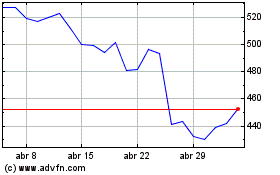Apple: The Only Big Tech Company That Has Not Announced Layoffs
19 Janeiro 2023 - 6:49AM
Finscreener.org
In the last few months, several
big tech companies on Wall Street announced layoffs as they
continue to wrestle with quantitative tightening measures, interest
rate hikes, supply chain disruptions, rising commodity prices, and
a global economic slowdown. Prior to the COVID-19 pandemic, these
companies enjoyed an elongated period of expansion.
Yesterday,
Microsoft (NASDAQ:
MSFT) announced it would
reduce its workforce by 5% or 10,000 employees, while
Amazon (NASDAQ:
AMZN) will reduce its
employee headcount by 18,000.
In recent months,
Alphabet (NASDAQ: GOOG) and Meta (NASDAQ:
META) also announced layoffs to reduce their cost base
and improve profit margins. Each of these companies has attributed
layoffs to challenging macro conditions and the possibility of an
upcoming recession. But tech companies across verticals also ramped
up hiring at an aggressive pace since March 2020, when the ongoing
pandemic first raised its ugly head.
As lockdowns were imposed all
over the world, demand for tech applications, products, and
services ramped up steeply, supercharging the revenue for many tech
companies. Most tech stocks in the U.S. reported record sales in
2021 and expanded their workforce to meet additional demand. But
they now have to readjust as growth is slowing rapidly in the near
term.
However,
Apple (NASDAQ: AAPL) is among
the few big tech giants that have not disclosed any layoffs. It
also did not increase its rate of hiring in the last two years.
Let’s compare the hiring strategies of Apple with its big tech
peers.
Microsoft: At
the end of June 2022, Microsoft had 221,000 full-time employees, an
increase of 22% year over year. In the year prior to that, it added
18,000 employees, increasing its workforce by 11% to keep up with
elevated demand.
Amazon: The
hiring structure of Amazon is complicated as it employs a
significant number of hourly employees for warehouses and delivery.
In 2021, Amazon added 310,000 jobs, while it grew its employee base
by 38% in 2020 when it added 500,000 workers. At the end of 2021,
its employee base stood at 1.6 million.
In a memo to employees, Amazon
explained, “During Covid, our first priority was scaling to meet
the needs of our customers while ensuring the safety of our
employees. I’m incredibly proud of this team’s work during this
period. Although other companies might have balked at the
short-term economics, we prioritized investing for customers and
employees during these unprecedented
times.”
Meta: In 2020,
Meta added 13,000 employees, increasing its total count by 30%. It
also added 13,000 workers in 2021, which was the two biggest
expansion years in the company’s history.
Alphabet:
Compared to other tech firms, Alphabet’s layoffs have been
marginal. It cut 240 jobs in its health sciences division and laid
off 40 more in the robotics vertical. Alphabet ended 2021 with
156,500 workers, an increase of 15% year over year. It also
increased workers by 16,000 in 2020, indicating an expansion of
14%.
In the last ten years, Alphabet
has increased its employee count by at least 10% annually. In fact,
in 2018 and 2019, its growth rates were well over 20%.
Apple: Unlike
its tech peers, Apple grew at a much slower pace during COVID-19.
The company’s hiring in 2020 and 2021 followed a similar trend
observed in the prior years. At the end of fiscal 2022 (ended in
September), Apple had 164,000 employees, an increase of 6.5% year
over year. It also added less than 7,000 employees in the year
before September 2021.
Meta Platforms (NASDAQ:META)
Gráfico Histórico do Ativo
De Mar 2024 até Abr 2024

Meta Platforms (NASDAQ:META)
Gráfico Histórico do Ativo
De Abr 2023 até Abr 2024
